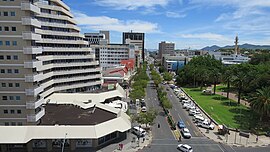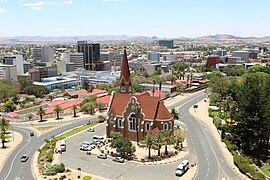Windhoek
Windhoek
ǀAi-ǁGams (Khoekhoegowab) Otjomuise (Otjiherero) Windhuk (German) | |
|---|---|
| City of Windhoek | |
| Motto: Suum Cuique (Latin for "To each his own") | |
| Coordinates: 22°34′12″S 17°5′1″E / 22.57000°S 17.08361°E | |
| Country | |
| Region | Khomas Region |
| First settled | 1840 |
| Second founding | 18 October 1890 |
| Government | |
| • Type | Mayor-council government |
| • Mayor | Fransina Kahungu (SWAPO)[1] |
| • Deputy Mayor | Ian Subasubani (SWAPO)[2] |
| Area | |
| • Total | 5,133 km2 (1,982 sq mi) |
| Elevation | 1,655 m (5,430 ft) |
| Population (2011)[3] | |
| • Total | 325,858 |
| • Density | 62.8/km2 (163/sq mi) |
| Time zone | UTC+2 (SAST) |
| Postal code | 10005 |
| Area code | 061 |
| Climate | BSh |
| Website | www |

Windhoek (/ˈwɪndhʊk/, Afrikaans: [ˈvəntɦuːk], German: ['vɪnthʊk]) is the capital and largest city of Namibia. It is located in central Namibia in the Khomas Highland plateau area, at around 1,700 metres (5,600 ft) above sea level, almost exactly at the country's geographical centre. The population of Windhoek in 2020 was 431,000[4] which is growing continually due to an influx from all over Namibia.
The city developed at the site of a permanent hot spring known to the indigenous pastoral communities. It developed rapidly after Jonker Afrikaner, Captain of the Orlam, settled here in 1840 and built a stone church for his community. In the decades following, multiple wars and armed hostilities resulted in the neglect and destruction of the new settlement. Windhoek was founded a second time in 1890 by Imperial German Army Major Curt von François, when the territory was colonised by the German Empire.
Windhoek is the social, economic, political, and cultural centre of the country. Nearly every Namibian national enterprise, governmental body, educational and cultural institution is headquartered there.
History
Etymology
Theories vary on how the place got its modern name of Windhoek. Most believe it is derived from the Afrikaans word wind-hoek (wind corner). Another theory suggests that Captain Jonker Afrikaner named Windhoek after the Winterhoek Mountains at Tulbagh in South Africa, where his ancestors had lived. The first known mention of the name Windhoek was in a letter from Jonker Afrikaner to Joseph Tindall, dated 12 August 1844.[5]
Pre-colonial
In 1840 Jonker Afrikaner established an Orlam settlement at Windhoek.[6] He and his followers stayed near one of the main hot springs, located in the present-day Klein Windhoek suburb.[7] He built a stone church that held 500 people; it was also used as a school. Two Rhenish missionaries, Carl Hugo Hahn and Franz Heinrich Kleinschmidt, started working there in late 1842. Two years later they were driven out by two Methodist Wesleyans, Richard Haddy and Joseph Tindall.[8][9] Gardens were laid out and for a while Windhoek prospered. Wars between the Nama and Herero peoples eventually destroyed the settlement. After a long absence, Hahn visited Windhoek again in 1873 and was dismayed to see that nothing remained of the town's former prosperity. In June 1885, a Swiss botanist found only jackals and starving guinea fowl amongst neglected fruit trees.[10]
Colonial era



A request by merchants from Lüderitzbucht resulted in the declaration of a German protectorate over what was called German South West Africa, which is today Namibia in 1884. The borders of the German colony were determined in 1890 and Germany sent a protective corps, the Schutztruppe under Major Curt von François, to maintain order.[11] Von François stationed his garrison at Windhoek, which was strategically situated as a buffer between the Nama and Herero peoples. The twelve strong springs provided water for the cultivation of produce and grains.
Colonial Windhoek was founded on 18 October 1890, when von François fixed the foundation stone of the fort, which is now known as the Alte Feste (Old Fortress).[12] After 1907, development accelerated as indigenous people migrated from the countryside to the growing town to seek work. More European settlers arrived from Germany and South Africa. Businesses were erected on Kaiser Street (presently Independence Avenue), and along the dominant mountain ridge over the city. At this time, Windhoek's three castles, Heinitzburg, Sanderburg, and Schwerinsburg, were built.
South African administration after World War I
The German colonial era came to an end after the end of World War I .[13] For the next five years, a South African military government administered South West Africa. [citation needed] Development of the city of Windhoek and the nation later to be known as Namibia came to a virtual standstill. After World War II, Windhoek's development gradually gained momentum, as more capital became available to improve the area's economy. [citation needed]
After 1955, large public projects were undertaken, such as the building of new schools and hospitals, tarring of the city's roads (a project begun in 1928 with Kaiser Street), and the building of dams and pipelines to stabilise the water supply.[10] The city introduced the world's first potable re-use plant in 1958, treating recycled sewage and sending it directly into the town's water supply.[14] On 1 October 1966 the then Administrator of South West Africa granted Windhoek the coat of arms, which was registered on 2 October 1970 with the South African Bureau of Heraldry. Initially a stylized aloe was the principal emblem, but this was amended to a natural aloe (Aloe littoralis) on 15 September 1972. The Coat of Arms is described as "A Windhoek aloe with a raceme of three flowers on an island. Crest: A mural crown Or. Motto: SUUM CUIQUE (To each his own)".[15]
Windhoek formally received its town privileges on 18 October 1965 on the occasion of the 75th anniversary of the second foundation of the town by von François.[16]
Since Namibian independence
Since independence in 1990, Windhoek has remained the national capital, as well as the provincial capital of the central Khomas Region. Since independence and the end of warfare, the city has had accelerated growth and development.
Geography
Expanding the town area has – apart from financial restrictions – proven to be challenging due to its geographical location. In southern, eastern and western directions, Windhoek is surrounded by rocky, mountainous areas, which make land development costly. The southern side is not suitable for industrial development because of the presence of underground aquifers. This leaves the vast Brakwater area north of town the only feasible place for Windhoek's expansion.[17]
Windhoek's City Council has plans to dramatically expand the city's boundaries such that the town area will cover 5,133.4 square kilometres (1,982.0 sq mi). Windhoek would become the third-largest city in the world by area, after Tianjin and Istanbul, although its population density is only 63 inhabitants per square kilometre.[18]
Suburbs
Windhoek is subdivided into the following suburbs and townships:[19]
Column-generating template families
The templates listed here are not interchangeable. For example, using {{col-float}} with {{col-end}} instead of {{col-float-end}} would leave a <div>...</div> open, potentially harming any subsequent formatting.
| Type | Family | Handles wiki
table code?† |
Responsive/ mobile suited |
Start template | Column divider | End template |
|---|---|---|---|---|---|---|
| Float | "col-float" | Yes | Yes | {{col-float}} | {{col-float-break}} | {{col-float-end}} |
| "columns-start" | Yes | Yes | {{columns-start}} | {{column}} | {{columns-end}} | |
| Columns | "div col" | Yes | Yes | {{div col}} | – | {{div col end}} |
| "columns-list" | No | Yes | {{columns-list}} (wraps div col) | – | – | |
| Flexbox | "flex columns" | No | Yes | {{flex columns}} | – | – |
| Table | "col" | Yes | No | {{col-begin}}, {{col-begin-fixed}} or {{col-begin-small}} |
{{col-break}} or {{col-2}} .. {{col-5}} |
{{col-end}} |
† Can template handle the basic wiki markup {| | || |- |} used to create tables? If not, special templates that produce these elements (such as {{(!}}, {{!}}, {{!!}}, {{!-}}, {{!)}})—or HTML tags (<table>...</table>, <tr>...</tr>, etc.)—need to be used instead.
Climate
Windhoek has over 300 sunny days per year.[20] It experiences a hot semi-arid climate (BSh) according to Köppen climate classification as the annual average temperature is above 18 °C (64 °F). The temperature throughout the year would be called mild, due to altitude influence. The annual average high and low temperature range is 13.4 °C (56.1 °F). The coldest month is July, with an average temperature of 13.1 °C (55.6 °F), while the hottest month is December, with average temperature 23.5 °C (74.3 °F). Due to its location near the Kalahari Desert, the city receives 3,605 hours of sunshine. Precipitation is abundant during the summer season, and minimal during the winter season. The average annual precipitation is 367.4 millimetres (14.46 in), with lows of 106.7 millimetres (4.20 in) in the 2018/19 rainy season, and 97 millimetres (3.8 in) in 1929/30.[21]
| Climate data for Windhoek (1728 m), Namibia | |||||||||||||
|---|---|---|---|---|---|---|---|---|---|---|---|---|---|
| Month | Jan | Feb | Mar | Apr | May | Jun | Jul | Aug | Sep | Oct | Nov | Dec | Year |
| Record high °C (°F) | 36.0 (96.8) |
35.8 (96.4) |
34.9 (94.8) |
31.3 (88.3) |
31.8 (89.2) |
26.1 (79.0) |
25.7 (78.3) |
30.0 (86.0) |
33.2 (91.8) |
35.0 (95.0) |
36.5 (97.7) |
36.6 (97.9) |
36.6 (97.9) |
| Mean daily maximum °C (°F) | 30.0 (86.0) |
28.6 (83.5) |
27.2 (81.0) |
25.6 (78.1) |
22.7 (72.9) |
20.2 (68.4) |
20.5 (68.9) |
23.4 (74.1) |
26.5 (79.7) |
29.1 (84.4) |
29.6 (85.3) |
30.7 (87.3) |
26.1 (79.0) |
| Daily mean °C (°F) | 23.3 (73.9) |
22.1 (71.8) |
21.0 (69.8) |
18.9 (66.0) |
15.8 (60.4) |
13.2 (55.8) |
13.1 (55.6) |
15.8 (60.4) |
19.3 (66.7) |
21.7 (71.1) |
22.5 (72.5) |
23.5 (74.3) |
19.1 (66.4) |
| Mean daily minimum °C (°F) | 17.2 (63.0) |
16.5 (61.7) |
15.4 (59.7) |
12.8 (55.0) |
9.2 (48.6) |
6.7 (44.1) |
6.3 (43.3) |
8.6 (47.5) |
11.9 (53.4) |
14.6 (58.3) |
15.6 (60.1) |
16.9 (62.4) |
12.7 (54.9) |
| Record low °C (°F) | 7.5 (45.5) |
6.8 (44.2) |
3.7 (38.7) |
2.4 (36.3) |
−1.6 (29.1) |
−2.8 (27.0) |
−2.6 (27.3) |
−3.9 (25.0) |
−1.1 (30.0) |
1.6 (34.9) |
0.4 (32.7) |
3.3 (37.9) |
−3.9 (25.0) |
| Average precipitation mm (inches) | 78.1 (3.07) |
80.3 (3.16) |
78.7 (3.10) |
37.7 (1.48) |
6.6 (0.26) |
1.2 (0.05) |
0.7 (0.03) |
0.9 (0.04) |
2.8 (0.11) |
11.8 (0.46) |
26.9 (1.06) |
41.7 (1.64) |
367.4 (14.46) |
| Average precipitation days (≥ 0.1 mm) | 11.1 | 10.7 | 10.5 | 5.5 | 1.9 | 0.7 | 0.5 | 0.3 | 0.9 | 2.8 | 5.3 | 7.5 | 57.7 |
| Average relative humidity (%) | 42 | 56 | 51 | 44 | 37 | 32 | 27 | 19 | 17 | 22 | 30 | 34 | 34 |
| Mean monthly sunshine hours | 288 | 254 | 282 | 273 | 310 | 309 | 326 | 341 | 321 | 319 | 297 | 285 | 3,605 |
| Source 1: Deutscher Wetterdienst[22] | |||||||||||||
| Source 2: Danish Meteorological Institute (sun only)[23] | |||||||||||||
Demographics
Ethnic groups
In 1971, there were roughly 26,000 whites living in Windhoek, outnumbering the black population of 24,000. About one third of white residents at the time, at least 9,000 individuals, were German speakers.[24] Windhoek's population currently[update] stands at over 325,858 (65% black; 17% white; 18% other), and is growing 4% annually in part due to informal settlements that have even higher growth rates of nearly 10% a year.[17]
Languages
In public life, Afrikaans, and to a lesser extent German, are still used as lingua francas even though the government only uses English.[25]
Historical population
| Year | Pop. | ±% p.a. |
|---|---|---|
| 1981 | 96,057 | — |
| 1991 | 147,056 | +4.35% |
| 2001 | 233,529 | +4.73% |
| 2011 | 325,858 | +3.39% |
| 2016 | 395,000 | +3.92% |
| source:[26] | ||
Politics
Windhoek is the only self-governed settlement in Khomas Region. It is governed by a multi-party municipal council that has fifteen seats.[27] The Council meets once a month (each last Wednesday of the month); its decisions are taken collectively and councillors are bound by such decisions. As individuals, council members have no administrative authority. They cannot give orders or otherwise supervise City employees unless specifically directed to do so by the Council. The Council, however, has complete authority over all administrative affairs in the city. Council members devote their official time to problems of basic policy and act as liaisons between the City and the general public.
SWAPO won the 2015 local authority election and gained twelve seats, by having 37,533 votes. Three opposition parties gained one seat each: The Popular Democratic Movement (PDM), formerly DTA, with 4,171 votes, the National Unity Democratic Organisation (NUDO) with 1,453 votes, and the Rally for Democracy and Progress (RDP) with 1,422 votes.[28]
Economy
The city is the administrative, commercial, and industrial center of Namibia. A 1992/93 study estimated that Windhoek provides over half of Namibia's non-agricultural employment, with its national share of employment in utilities being 96%, in transport and communication 94%, finance and business services 82%.[29] Due to its relative size[30] Windhoek is, even more than many other national capital cities, the social, economic, and cultural centre of the country. Nearly every national enterprise is headquartered here. The University of Namibia is, too, as are the country's only theatre, all ministry head offices, and all major media and financial entities.[31] The governmental budget of the city of Windhoek nearly equals those of all other Namibian local authorities combined.[32] Of the 3,300 US$-millionaires in Namibia, 1,400 live in Windhoek.[33]
Transport
Rail

Windhoek is connected by rail to:
Road


In 1928, Kaiserstraße, now Independence Avenue, was the first paved road in Windhoek. Ten years later the next one, Gobabis road, now Sam Nujoma Drive, was also paved. Today out of ca. 40,000 kilometres (25,000 mi) of Namibia's total road network, about 5,000 kilometres (3,100 mi) is sealed.
Windhoek's three main access roads from Rehoboth, Gobabis, and Okahandja are paved, and are designed to be able to withstand the largest possible flood to be expected in fifty years. Sealed roads can carry traffic moving at 120 kilometres per hour (75 mph) and should last for 20 years.
In 2014, The Roads Authority has planned to upgrade the Windhoek-Okahandja road to a dual carriage way. It costs about N$1 billion and is expected to be completed in 2021.
Later on, they also planned to upgrade the Windhoek and Hosea Kutako International Airport to a dual carriageway and is expected to be completed in 2022.
As everywhere in Namibia, public transport is scarce and transportation across town is largely done by taxi; there were 6,492 registered taxis in 2013.[34]
Air transportation
Windhoek is served by two airports. The closest one is Eros 7 kilometres (4.3 mi) south of the city center for smaller craft, and Hosea Kutako International Airport 42 kilometres (26 mi) east of the city. A number of foreign airlines operate to and from Windhoek. Air charters and helicopter and fixed-wing aircraft rentals are also available.

Hosea Kutako International Airport handles over 800,000 passengers a year. It has one runway without capacity limitations. The other international airport is located in Walvis Bay, with domestic airports at Luderitz, Oranjemund and Ondangwa.
Eros Airport is the busiest airport in Namibia in terms of take offs and landings and a domestic hub for Air Namibia.[35] This city airport handles approximately 150 to 200 movements per day (around 50,000 per year). In 2004, the airport served 141,605 passengers, the majority of which are light aircraft. Primarily, limitations such as runway length, noise, and air space congestion have kept Eros from developing into a larger airport. Most of Namibia's charter operators have Eros as their base.
Culture
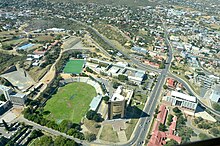
Windhoek is known as the art capital of Namibia. The National Art Gallery of Namibia is located in Windhoek.
The National Museum of Namibia is located in Windhoek with two locations [36] Alte Feste Museum (historical): showcases a range of colonial items such as wagons and domestic items. Owela Museum (scientifically - named after a traditional game played with pebbles): contains displays of minerals, fossils and meteorites and gives an insight into traditional village life. There are also the Independence Memorial Museum, the National Library of Namibia and the Windhoek Public Library – built in 1925, next to the Alte Feste.[37]
Places of worship

The places of worship are predominantly Christian churches and temples: Evangelical Lutheran Church in Namibia (Lutheran World Federation), Evangelical Lutheran Church in the Republic of Namibia (Lutheran World Federation), Baptist Convention of Namibia (Baptist World Alliance), Assemblies of God, Roman Catholic Archdiocese of Windhoek (Catholic Church).[38] There are also a few Islamic mosques in the city.
Architecture
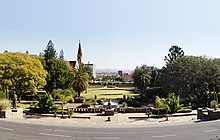
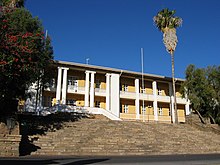
- Alte Feste – (Old Fortress) Built in 1890, today houses the National Museum.
- Curt von François monument in front of the municipality building. Inaugurated on 18 October 1965 on the occasion of the 75th anniversary of the second foundation of the town by von François.[16]
- Heroes' Acre
- Reiterdenkmal (Equestrian Monument), a statue celebrating the victory of the German Empire over the Herero and Nama in the Herero and Namaqua War of 1904–1907[39] The statue has been removed from its historical place next to Christuskirche in December 2013 and is now on display in the yard of the Alte Feste.[40]
- Supreme Court of Namibia – situated in Michael Scott Street on Eliakim Namundjebo Plaza. Built between 1994 and 1996[41] it is Windhoek's only building erected post-independence in an African style of architecture.[42]
- The three castles of Windhoek built by architect Wilhelm Sander: Heinitzburg, Sanderburg, and Schwerinsburg[43]
- Tintenpalast – (Ink Palace) within Parliament Gardens, the seat of both chambers of the Parliament of Namibia. Built between 1912 and 1913 and situated just north of Robert Mugabe Avenue.
- Turnhalle – neo-classicist building of Wilhelmine architecture, inaugurated in 1909.[44]
- Windhoek Railway Station
- Zoo Park – a public park on Independence Avenue in downtown Windhoek. The current park is landscaped and features a pond, playground and open-air theatre.[45]
Sport
Rugby is a popular sport in Namibia, and the national team is called the Welwitchias. Namibia has made the Rugby World Cup on six occasions, in 1999, 2003, 2007, 2011, 2015 and 2019, but has never won a game.
The city has several football clubs which include African Stars F.C., Black Africa F.C., F.C. Civics Windhoek, Orlando Pirates F.C., Ramblers F.C. and SK Windhoek, Tigers F.C., Tura Magic F.C., Citizens F.C.
Many boxers such as Paulus Moses, Paulus Ambunda and Abmerk Shindjuu are from the city.
The Namibia national cricket team, the Eagles, plays the majority of its home games at the Wanderers Cricket Ground.[46] It has also played at other grounds in the city, including the United Ground and the Trans Namib Ground.[47][48] The team took part in the 2003 Cricket World Cup in South Africa, though they lost all their games. They have played in each edition of the ICC Intercontinental Cup.
Men's baseball was introduced to Namibia in 1950 at the Ramblers sports club in town.
The 'Tony Rust Raceway' is located west of Windhoek on the Daan Viljoen road, and reopened in 2007.[49]
Education
Tertiary institutions
The general institutions of higher education in Windhoek are:
- University of Namibia (UNAM)
- Namibia University of Science and Technology (NUST), until 2015 the Polytechnic of Namibia
- International University of Management (IUM)
Other institutions
Other recognisable institutions of higher learning:
- Institute of Information Technology (IIT)
- College of the Arts (COTA)
Secondary schools
Windhoek has[update] 29 secondary schools and 58 primary schools.[50] Some of the notable schools are:
- A. Shipena Secondary School
- Academia Secondary School
- Augustineum Secondary School
- Centaurus High School
- Concordia College
- Dagbreek School for the Intellectually Impaired[51]
- David Bezuidenhout Secondary School
- Delta Secondary School Windhoek (DSSW)
- Deutsche Höhere Privatschule (DHPS)
- Eldorado Secondary School
- Ella du Plessis Secondary School
- Eros School for Girls[52]
- Goreangab Secondary School
- Immanuel Shifidi Secondary School
- Jan Jonker Afrikaner High School
- Jan Mohr Secondary School
- Saint George's Diocesan College[53]
- Saint Paul's College
- Combretum Trust School
- Windhoek Afrikaanse Privaatskool
- Cosmos High School (CHS)
- Windhoek Gymnasium Private School (WGPS)[54]
- Windhoek High School (WHS)
- Windhoek International School (WIS)
- Windhoek Technical High School (HTS)
International relations
Windhoek is twinned with:[55]
 Shanghai, since 1 June 1996
Shanghai, since 1 June 1996 Richmond, Virginia, since 20 March 1998
Richmond, Virginia, since 20 March 1998 Wetzlar
Wetzlar Berlin, since 18 April 2000[56]
Berlin, since 18 April 2000[56] Trossingen, since 3 October 2000
Trossingen, since 3 October 2000 Bremen, since 18 April 2000
Bremen, since 18 April 2000 Douala, since 31 August 2000
Douala, since 31 August 2000 Harare, since 8. November 2000
Harare, since 8. November 2000 Johannesburg, South Africa
Johannesburg, South Africa Gaborone, since 23 August 2001
Gaborone, since 23 August 2001 Havana, since 23 October 2001
Havana, since 23 October 2001 Eenhana, since 17 April 2002
Eenhana, since 17 April 2002 Kingston, since 6 February 2019[57]
Kingston, since 6 February 2019[57] Ongwediva, since 17 April 2002
Ongwediva, since 17 April 2002 Ondangwa, since 17 April 2002
Ondangwa, since 17 April 2002 Outapi, since 17 April 2002
Outapi, since 17 April 2002 Oshakati, since 18 April 2002
Oshakati, since 18 April 2002 Lephalale, since 22 May 2002
Lephalale, since 22 May 2002 San Antonio, Texas, since 27 October 2016[58]
San Antonio, Texas, since 27 October 2016[58] Walvis Bay, since 8 October 2002
Walvis Bay, since 8 October 2002 Mariental, since 11 March 2003
Mariental, since 11 March 2003 Gibeon, since 11 March 2003
Gibeon, since 11 March 2003 Maltahöhe, since 12 April 2002
Maltahöhe, since 12 April 2002 Aranos, since 13 March 2003
Aranos, since 13 March 2003 Stampriet, since 13 March 2003
Stampriet, since 13 March 2003 Rehoboth, since 14 March 2003
Rehoboth, since 14 March 2003 Lüderitz, since 14 March 2003
Lüderitz, since 14 March 2003
See also
References
- ^ City of Windhoek, 2019-12-16
- ^ [1]
- ^ "Table 4.2.2 Urban population by Census years (2001 and 2011)" (PDF). Namibia 2011 – Population and Housing Census Main Report. Namibia Statistics Agency. p. 39. Retrieved 24 August 2016.
- ^ "Windhoek, Namibia Population 1950-2020". www.macrotrends.net. Retrieved 14 March 2020.
- ^ Dierks, Klaus. "The History of ǁKhauxaǃnas. Introduction". Retrieved 9 July 2010.
- ^ "The Orlams Afrikaners – the Creole Africans of the Garieb". Cape Slavery Heritage. Retrieved 8 July 2010.[permanent dead link]
- ^ Tonchi, Victor L; Lindeke, William A; Grotpeter, John J (2012). Historical Dictionary of Namibia. Historical Dictionaries of Africa, African historical dictionaries (2 ed.). Scarecrow Press. ISBN 9780810879904.
- ^ Vedder, Heinrich (1997). Das alte Südwestafrika. Südwestafrikas Geschichte bis zum Tode Mahareros 1890 [The Old South West Africa. South West Africa's History until Maharero's death 1890] (in German) (7th ed.). Windhoek: Namibia Scientific Society. ISBN 0-949995-33-9.
- ^ Dierks, Klaus. "Biographies of Namibian Personalities, A (entry for Jonker Afrikaner)". klausdiers.com. Retrieved 1 October 2011.
- ^ a b Windhoek City Council: The History of Windhoek Archived 21 February 2010 at the Wayback Machine
- ^ Roman Adrian Cybriwsky, Capital Cities around the World: An Encyclopedia of Geography, History, and Culture, ABC-CLIO, USA, 2013, p. 338
- ^ Dierks, Klaus. "Biographies of Namibian Personalities, V (entry for Curt von François)". klausdiers.com. Retrieved 1 October 2011.
- ^ Britannica, Windhoek, britannica.com, USA, accessed on July 7, 2019
- ^ "Surviving in an arid land: Direct reclamation of potable water at Windhoek's Goreangab Reclamation Plant" by Petrus Du Pisani
- ^ Berry, Bruce (12 February 2014). "Windhoek (Namibia)". www.crwflags.com. Retrieved 8 September 2017.
- ^ a b "Windhoek erhielt heute Stadtrechte" [Windhoek received town privileges today]. Allgemeine Zeitung (in German) (2015 reprint ed.). 18 October 1965.
- ^ a b "Windhoek's battle for land", by Desie Heita; New Era, 10 Feb 2010
- ^ Retief, Christo (2 July 2013). "Windhoek slaan Afrika-rekord" [Windhoek beats Africa record]. Die Republikein.
- ^ "The Windhoek Structure Plan" (PDF). City of Windhoek. 1996. pp. 11–12. Retrieved 2 July 2013.[permanent dead link]
- ^ "Climate and average monthly weather in Namibia". weather-and-climate.com.
- ^ Menges, Werner; Oliveira, Yokany (23 May 2019). "Khomas faces worst drought in 90 years". The Namibian. p. 1.
- ^ "Klimatafel von Windhuk (Windhoek) / Namibia" (PDF). Federal Ministry of Transport and Digital Infrastructure. Retrieved 2 November 2016.
- ^
"Stationsnummer 68110" (PDF). Ministry of Energy, Utilities and Climate. Archived from the original on 16 January 2013. Retrieved 2 November 2016.
{{cite web}}: CS1 maint: bot: original URL status unknown (link) - ^ "Reading Eagle - Google News Archive Search". news.google.com.
- ^ Thomas Schoch. 2003. Visit Windhoek, People and languages Archived 22 February 2013 at archive.today
- ^ Namibia: Administrative Division population statistics
- ^ "Know Your Local Authority". Election Watch. No. 3. Institute for Public Policy Research. 2015. p. 4.
- ^ "Local elections results". Electoral Commission of Namibia. 28 November 2015. p. 4. Archived from the original on 10 December 2015.
- ^ "The Windhoek Structure Plan" (PDF). City of Windhoek. 1996. p. 6. Retrieved 2 July 2013.[permanent dead link]
- ^ The second biggest city in Namibia, Walvis Bay, has 43,700 inhabitants: "ELECTIONS 2010: Erongo regional profile". New Era. 16 November 2010.
- ^ Kapitako, Alvine (12 November 2010). "ELECTIONS 2010: Khomas Region profile". New Era. Archived from the original on 5 December 2012.
- ^ Heita, Desie (11 February 2010). "Owning a house ... a dream deferred". New Era. Archived from the original on 16 July 2011.
- ^ Nakashole, Ndama (24 April 2017). "Namibians 3rd wealthiest people in Africa". The Namibian. p. 13.
- ^ Shipanga, Selma (3 April 2013). "A glimpse into the taxi industry". The Namibian. pp. 6–7.
- ^ "Archived copy". Archived from the original on 4 September 2012. Retrieved 9 October 2011.
{{cite web}}: CS1 maint: archived copy as title (link) - ^ https://www.museums.com.na/museums/windhoek/national-museum-of-namibia National Museum of Namibia
- ^ Shejavali, Nangula (19 February 2009). "National News 19.02.2009 Public library gets a facelift". The Namibian. Archived from the original on 12 January 2013.
- ^ J. Gordon Melton, Martin Baumann, ‘‘Religions of the World: A Comprehensive Encyclopedia of Beliefs and Practices’’, ABC-CLIO, USA, 2010, p. 2012-2013
- ^ Bause, Tanja (30 January 2012). "Monument's centenary remembered". The Namibian. Archived from the original on 9 December 2012.
- ^ Steynberg, Francoise (27 December 2013). "Ruiter val op heiligste dag" [Rider falls on holiest day]. Die Republikein (in Afrikaans). Archived from the original on 1 July 2014.
- ^ "Windhoek Supreme Court". Windhoek Consulting Engineers. Archived from the original on 15 March 2012. Retrieved 24 November 2010.
- ^ "Windhoek on Foot". Venture Publications. Archived from the original on 3 June 2013. Retrieved 24 November 2010.
- ^ Dierks, Klaus. "Biographies of Namibian Personalities, S". klausdierks.com. Retrieved 3 October 2011.
- ^ Vogt, Andreas (18 December 2009). "100 years Turnhalle • From gymnasium to Tribunal". Die Republikein.
- ^ "Windhoek Attractions, Namibia". Sa-venues.com. Archived from the original on 25 November 2009. Retrieved 1 October 2009.
- ^ Wanderers Cricket Ground, Windhoek, CricketArchive Retrieved 26 September 2011.
- ^ United Ground, Windhoek, CricketArchive Retrieved 26 September 2011.
- ^ Trans Namib Ground, Windhoek, CricketArchive Retrieved 26 September 2011.
- ^ Galpin, Darren. "Tony Rust Raceway, Windhoek". GEL Motorsport Information Page. Archived from the original on 10 June 2017. Retrieved 31 December 2018.
- ^ "Schools in Windhoek under pressure for places". The Namibian. Nampa. 15 January 2016. p. 6.
- ^ Du Plessies, P.S. "Dagbreek school Windhoek Namibia-school for learners who are intellectually impaired". Archived from the original on 26 April 2012.
- ^ Sergei Mitrofanov. "Eros School for Girls". namibweb.com. Retrieved 1 October 2009.
- ^ "Saint George's Diocesan College". stgeorgesnamibia.com. Retrieved 12 October 2015.
- ^ Nakale, Albertina (20 May 2014). "Private school draws praise from Namwandi". New Era.
- ^ "Status of Cooperation Agreement" (PDF). Archived from the original (PDF) on 16 February 2012. Retrieved 1 October 2009.
- ^ "Berlin – City Partnerships". Der Regierende Bürgermeister Berlin. Archived from the original on 21 May 2013. Retrieved 17 September 2013.
- ^ http://www.xinhuanet.com/english/2019-02/06/c_137803189.htm
- ^ "Windhoek becomes first San Antonio Sister City in Africa, 10th total".

